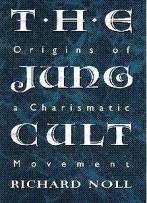
a book review by
Mary Lynn Richardson
By Richard Noll. Princeton University Press, 1994.
(Reprinted in papberback, June 1997.)
But the question remains: How did a book so which utterly fails to make its point, or to substantiate claims such as
The cult legend of Jung that has been faithfully maintained after his death by the Jungian movement (especially its analytic elite) resembles the sociological phenomenon of "manufactured pseudocharisma" by which mass media is used by power-seeking elites to promote seductive fantasy images in order to secure and maintain economic and social rewards
come to be published by Princeton, the press which brings us the whole corpus of Jung's Collected Works and many other classics of Jungian literature? And how, on the basis of this book, did Richard Noll publish in The New York Times an editorial artfully linking Jung and this "Swiss cult of middle-class, sun-worshipping neopagans led by a charismatic man who experienced himself to be Christ" with the names of David Koresch, Jim Jones and Luc Jouret?
These are questions I, for one, took seriously; they remain unanswered.
Yet here is a book which at least gives the impression of a scholarly work, prickling with footnotes (but alas no bibliography), and brimming with slippery insinuations which somehow fall just short enough of full allegations that one suspects a bevy of lawyers combed the text to make sure Princeton University Press could not be caught on charges of libel. If the copy editors had been as diligent, certain omissions in the "scholarly" documentation, and redundancies in the text, might have been rectified. I find it hard to imagine even the most skilled editor producing out of Noll's rhetorical morass a volume with readable text and aesthetic integrity. Indeed, the only light and warmth and energy -- the only logical coherence even -- enter the book in the form of quotations from other works, primarily Jung's.
This is not to say Noll's Jung Cult is without interest. As an Historian of Science, Noll has a good grasp of the milieu of scientific currents of thought in the fin de siècle Europe of a century ago, and it is indeed fascinating to see how similar these currents are in our own fin de siècle times. But in text replete with references to Naziism and anti-Semitism, Noll spends half the book stacking flimsy reference cards to build castles in the air, only to reach the astounding conclusion that
The best that can be said is that the evidence is compelling that Jung's work arose from the same central European cauldron of neopagan, Nietzschean, mystical, hereditarian, völkisch utopianism out of which National Socialism arose.
After this climax, The Jung Cult (which Noll informs us, in the middle of a tedious paragraph on p.223 is, after all, only his hypothesis) goes steadily downhill. That it regresses into a diatribe against Jung and his "disciples" is clear; what is not clear is whether Noll is castigating Jung for being too secretive or too revealing; too independent or not independent enough. Noll's entire "charismatic cult hypothesis" turns out to be tenuously supported by a passage in one of Jung's most studied works, in which Jung speaks painfully of his own brushes with inflation and its unpleasant (as well as pathological) effects.
There is also the business of Jung's "self-deification" and his "sun-worshipping" -- which facts, according to Noll, would be repugnant to the countless thousands of devout Christian or Jewish Jungians today if they fully understood the meaning behind his argument. I, for one, do not. Indeed I had to go back and search the already carefully read text to discover Noll's evidence for these "facts." Finally I understood Noll's case for the self-deification comes from an active imagination, and from a mandala for the sun-worshipping.
Perhaps the most useful passage in understanding Noll's book is his discussion of syncretism, which is defined as "an attempted blending of irreconcilable religious or philosophical principles -- always unintelligible at first to those not in the original melting pot that inspired the work." Whether or not this concept helps us to understand Jung's 1912 Wandlungen und Symbole der Libido (Symbols of Transformation) as Noll claims, it certainly captures the very essence of The Jung Cult.
1Reprinted from the Society News of the C.G.Jung Society of Calgary in Alberta, 4(1):4, 1995, and The Washington Society for Jungian Psychology: Member's Book Review 4:, 1996. Return
All rights reserved